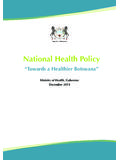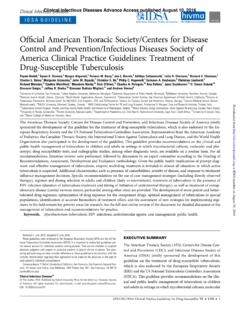Transcription of NATIONAL STRATEGIC PLAN FOR TUBERCULOSIS …
1 1 revised NATIONAL TUBERCULOSIS Control Programme NATIONAL STRATEGIC PLAN FOR TUBERCULOSIS ELIMINATION 2017 2025 March 2017 Central TB Division, Directorate General of Health Services, Ministry of Health with Family Welfare, Nirman Bhavan, New Delhi 110 108 i CONTENTS Contents .. i Acronyms .. 2 Executive Summary .. 5 Chapter 1 Introduction .. 10 Chapter 2 Developing the NSP .. 15 Chapter 3 Programme Indicators DETECT Chapter 4 Lab systems and Diagnosis .. 18 Chapter 5 Case finding .. 22 Chapter 6 Patients in Private Sector .. 25 TREAT Chapter 7 Treatment Service .. 37 Chapter 8 Key affected Populations .. 45 Chapter 9 Patient Support Systems .. 55 PREVENT Chapter 10 Air borne infection control .. 62 Chapter 11 Contact tracing .. 65 Chapter 12 Latent TB infection treatment .. 66 BUILD Chapter 13 Urban TB control systems .. 69 Chapter 14 Health System Strengthening.
2 73 Chapter 15 Advocacy, Communication and Social Mobilization / TB Campaign .. 81 Chapter 16 Surveillance, Monitoring and Evaluation .. 85 Chapter 17 Research .. 89 Chapter 18 Technical Assistance .. 91 RESOURCING THE NSP Chapter 19 Procurement and Supply Chain Management .. 93 Chapter 20 Costing and Financing the NSP .. Error! Bookmark not defined. Chapter 21 implementation of the NSP .. 103 2 ACRONYMS AIDS Acquired Immuno- Deficiency Syndrome ACSM Advocacy Communication with Social Mobilisation ANM Auxiliary Nurse Midwife ART Anti-Retroviral Therapy ARTI Annual Risk of TUBERCULOSIS Infection ASHA Accredited Social Health Activist AWW Anganwadi Worker BPHC Block Primary Health Centre BPL Below Poverty Line CCC Community Care Centres CDHO Chief District Health Officer CDMO Chief District Medical Health Officer CFR Case Finding Report CSO Civil Society Organisation CGHS Central Government Health Scheme CHC Community Health Centre CIDA Canadian International Development Agency CMO Chief Medical Officer CTD Central TB Division CPT Cotriamoxazole Preventive Therapy DR Drug resistant DS Drug sensitive DCC District Coordinating Committee DDG Deputy Director General.
3 TB DEO Data Entry Operator DFID Department for International Development, of the United Kingdom DGHS Directorate General of Health Services DLN District Level Network of PLHIV DM District Magistrate DMC Designated Microscopy Centre DOT Directly Observed Treatment DOTS Directly Observed Treatment, Short-Course DPM Deputy Programmer Manager DRS Drug Resistance Surveillances DST Drug Sensitivity Testing DR-TB Drug resistant TUBERCULOSIS DS-TB Drug Sensitive TUBERCULOSIS DTC District TUBERCULOSIS Centre DTCS District TB Control Society DTO District TUBERCULOSIS Officer EPTB Extra pulmonary TUBERCULOSIS EQA External Quality Assessment ESI Employees State Insurance ESR Erythrocyte Sedimentation Rate FBO Faith Based Organisation FICTC Facility Integrated Counselling and Testing Centre FNAC Fine Needle Aspiration Cytology GDF Global Drug Facility GFATM Global Fund for AIDS, TB and Malaria 3 HA Health Assistant HIV Human Immune- Deficiency Virus HRD Human Resource Development IEC Information.
4 Education and Communication ICF Intensive Case Finding ICTC Integrated Counselling and Testing Centre ILFS Infrastructure Leasing and Financial Services IPT Isoniazid Preventive Therapy IRLs Intermediate Reference Laboratories LAC Link ART Centres LQAS Lot Quality Assurance Sampling LRS Lala Ram Swarup Institute of TUBERCULOSIS and Respiratory Diseases. New Delhi LT Laboratory Technician LWS Link Worker Scheme MBPH Market Based Partnerships for Health MDG Millennium Development Goal MDR-TB Multi Drug Resistant TUBERCULOSIS MO Medical Officer MOHFW Ministry of Health with Family Welfare MO-TC Medical Officer TUBERCULOSIS Control MPHS Multi Purpose Health Supervisors MPW Multi-Purpose Workers NACP NATIONAL AIDS Control Programme NAICC NATIONAL Airborne Infection Control Committee NARI NATIONAL AIDS Research Institute NCRL NATIONAL Commission on Rural Labour NGO Non-Governmental Organization NRLs NATIONAL Reference Laboratories NHM NATIONAL Health Mission NTRI NATIONAL TUBERCULOSIS Research Institute.
5 Chennai NSP New smear positive NSP-RNTCP NATIONAL STRATEGIC Plan for TUBERCULOSIS Control NTF NATIONAL Task Force NTI NATIONAL TUBERCULOSIS Institute Bangalore NTP NATIONAL TUBERCULOSIS Programme NUHM NATIONAL Urban Health Mission OPD Out Patient Department OR Operational Research ORW Out Reach Worker OSE On-Site Evaluation INTERPHASE AGENCIES Private Provider Interface agency PHC Primary Health Centre PHI Peripheral Health Institution PHW Peripheral Health Worker PLHIV People Living with HIV/AIDS PPM Public Private Mix/ Partnership PMR Programme Management Report PP Private Practitioner PRI Panchayati Raj Institution PT Preventive Therapy PTB Pulmonary TUBERCULOSIS PVPI Pharmacovigilance programme of India PWB Patient Wise Box QA Quality Assurance QC Quality Control 4 QI Quality Improvement RBRC Random Blinded Rechecking RKS Rogi Kalyan Samity RNTCP revised NATIONAL TUBERCULOSIS Control Programme RTR Results of Treatment Report SA Statistical Assistant SACS State AIDS Control Society SC Sub Centre SCC State Coordinating Committee SC/ST Scheduled Caste/ Scheduled Tribe SCR Sputum Conversion Report SOE Statement of Expenditure SPCB State Pollution Control board STCS State TUBERCULOSIS Control Society STDC State TUBERCULOSIS Training and Demonstration Centres STF State Task Force STLS Senior TUBERCULOSIS Laboratory Supervisor STO State TUBERCULOSIS Officer STS Senior Treatment Supervisor TB TUBERCULOSIS TBHV TUBERCULOSIS Health Visitor TH Taluk Hospital TI Targeted Intervention TO Treatment organization TSG Technical Support Group TU TUBERCULOSIS Unit NTGW NATIONAL Technical Working Group USAID United States Agency for International Development VCTC
6 Voluntary Testing and Counselling Centre VHND Village Health and Nutrition Day VHSC Village Health and Sanitation Committee WHO World Health Organization XDR Extensively Drug Resistant ZTF Zonal Task Force 5 EXECUTIVE SUMMARY India has been engaged in TUBERCULOSIS (TB control activities for more than 50 years). Yet TB continues to be India s severest health crisis. TB kills an estimated 480,000 Indians every year and more than 1,400 every day. India also has more than a million missing cases every year that are not notified and most remain either undiagnosed or unaccountably and inadequately diagnosed and treated in the private sector. This tragic loss of life, continued suffering, poverty need to end with concerted efforts from all of us. India is now better prepared to address TB better than ever before. It possesses advanced and effective interventions and technologies for diagnosis, treatment and care of TB.
7 This NSP for 2017 25 for TB elimination in India (NSP) embraces these opportunities to leverage its full potential and proposes transformational changes to TB care service delivery. Over the last NS period, we made significant gains in strengthening the support structures, programme architecture and implementation environment for TB control. This includes mandatory notification of all TB cases, integration of the programme with the general health services ( NATIONAL Health Mission), expansion of diagnostics services, programmatic management of drug resistant TB (PMDT) service expansion, single window service for TB-HIV cases, NATIONAL drug resistance surveillance and revision of partnership guidelines. However, we have to recognize that more needs to be done to drastically reduce the TB incidence in India. We need aspirational objectives, a thoughtful and structured approach and a supportive environment.
8 The NSP 2017-2025 builds on the success and learnings of the last NSP and encapsulates the bold and innovative steps required to eliminate TB in India by 2030. It is crafted in line with other health sector strategies and global efforts, such as the draft NATIONAL Health Policy 2015, World Health Organization s (WHO) End TB Strategy, and the Sustainable Development Goals (SDGs) of the United Nations (UN). The NSP for TB elimination 2017 -2025 The NSP for TB elimination 2017 25 is a framework to guide the activities of all stakeholders including the NATIONAL and state governments, development partners, civil society organizations, international agencies, research institutions, private sector, and many others whose work is relevant to TB elimination in India. The NSP 2017-2025 which builds on the success and learnings of the last NSP, and articulates the bold and innovative steps required to move towards TB elimination, is a 3 year costed plan and a 8 year strategy document.
9 It provides goals and strategies for the country s response to the disease during the period 2017 to 2025 and aims to direct the attention of all stakeholders on the most important interventions or activities that the RNTCP believes will bring about significant changes in the incidence, prevalence and mortality of TB. These strategies and interventions are in addition to the processes and activities already ongoing in the country. As a STRATEGIC document, the subsequent operational plans will necessarily follow. The NSP will guide the development of the NATIONAL project implementation plan (PIP) and state PIPs, as well as district health action plans (DHAP) under the NATIONAL health mission (NHM). This NSP replaces previous strategies, and will inform and guide the technical and operational guidelines refresh and associated programme tools modifications.
10 The development of this NSP has been a collaborative effort between all the stakeholders including NATIONAL and state governments, development partners, civil society organizations, and private sector in India which was led by the Central TB Division, Ministry of Health and Family Welfare. Knowledge and insights generated from a series of workshops and consultations with the 6 stakeholders, learnings from the implementation of the past NSP and experiences from the pilots, models and approaches tested over the last NSP period informed the strategies proposed in the current NSP. Vision, Goals and Targets of NSP The NSP proposes bold strategies with commensurate resources to rapidly decline TB in the country by 2030 in line with the global End TB targets and Sustainable Development Goal s to attain the vision of a TB-free India.





